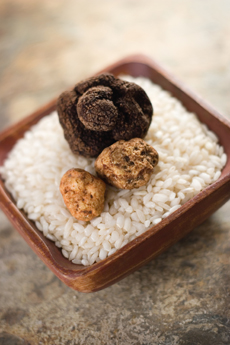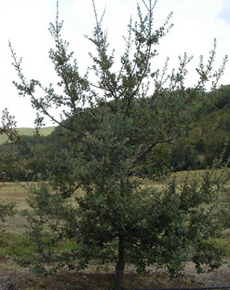
 Costlier than gold: the Périgord truffle of France and the white Alba truffle of the Piedmont, in Italy. Photos by Kelly Cline | IST.
Costlier than gold: the Périgord truffle of France and the white Alba truffle of the Piedmont, in Italy. Photos by Kelly Cline | IST.
|
|
|
KAREN HOCHMAN is Editorial Director of THE NIBBLE.
|
|
December 2006
Last Updated November 2013
|
 |
Truffles: An Overview & Glossary
Black Périgord Truffles and White Alba Truffles Are Two Of Life’s Great Luxuries
Page 1: What Is A Truffle
CAPSULE REPORT: Truffles, at $1,000 a pound and more, are among the most expensive foods in the world. If we received a great year-end bonus and wanted to splurge, this is what we’d splurge on. We don’t need a whole pound—an ounce or two would be treat enough. While the experience is ephemeral, the memories last forever. But buying truffles is like buying Persian carpets: You need to study up and know what to buy, or you can be taken by fast-talkers. There are major league truffles and minor league truffles—and many a purveyor would sell you the minor leaguers at major league prices. If you’re going to have a truffle experience, make it a great one. Otherwise, you’ll spend the rest of your life wondering what everyone’s raving about. This is Page 1 of a 12-page article. Click on the black links below to visit other pages.
Truffle Overview
Truffles are members of the Tuber genus like their cousins, the mushrooms, but they are the only “subterranean” fungi, growing from 2 to 15 inches below the ground, depending on the species. What sets them apart from other mushrooms is not that they grow underground, but that they have a symbiotic relationship with trees (non-culinary species can develop on other plants). They attach to the roots of trees and issue long tendrils that gather nutrition for the plant. The carbohydrates that are returned from the host tree eventually form the “fruit” that we call truffles. There are about 60 species of true truffle, but only a dozen have culinary value—and of those, only a handful are so rare and celestial as to command $1,000 a pound and more.
Such princely truffles, found in Europe, are the subject of this article. They grow often about 4 to 5 feet from the base of three species of oak trees* (known as “truffle oaks”) and usually in a circular formation. Oaks don’t have the monopoly: Truffles sometimes are found near beech, chestnut and hazelnut trees, as well as ash, elm, linden and poplar. Because truffles grow on the roots of the trees, the key is a host tree that grows at low altitude and has a large network of roots, and grows in crumbly soil (called “friable”), covered in humus, the dark organic material in soils produced by the decomposition of vegetable or animal matter.
|
Because they can’t be seen attached to the trees’ roots, truffles need to be sniffed out. That’s why truffle-hunting pigs were used for many years to find them: The human nose isn’t sensitive enough to find them under the earth. But because the pigs were too prone to eating the delectable truffles once they found them, they were replaced by dogs, who are less greedy and easier to restrain. If you have neither pig nor trained dog, you can wander the woods with a sapin (the special pickaxe-spade used for digging truffles) and learn to identify the Suillia fly, an insect that likes to lay its eggs above truffles. Look for the fly homing in close to the ground, and start digging. If you’re in Périgord, look for a dark patch around the tree (called brulée, burned, in French). This is a protective antibiotic drenching the soil, thrown off by Tuber melanosporum, the black Périgord truffle, underneath.
|
|

Truffe oak tree. Photo courtesy Truffle-Tree.com. |
*Red oak (Quercus robur), holly oak (Quercus ilex) and pubescent oak (Quercus pubescens).
The fine truffle industry is in the midst of an historic crisis. Total annual European production has fallen from 2,000 tonnes at the end of the 19th century to just 60 tonnes in the 2008-2009 season. The decline is based on unkempt woods, a result of the population exodus from the countryside (truffles need a light, airy environment) and on global warming, which has upset the balance of sun and rain.
If the trend continues, specialists warn that French truffles could disappear altogether. Recent research Italian researchers has revealed that truffles are born of a meeting of male and female spores. While this may seem a no-brainer to the casual reader, it is actually a revelation that could help to bring about a revival of production after 100 years of decline, explaining why some mychorized trees (those which have been specially treated at the roots with the hopes of growing truffles) don’t produce results.†
†Times Online, January 30, 2009
Continue To Page 2: Truffles Are Not Mushrooms!
Go To The Article Index Above
Lifestyle Direct, Inc. All rights reserved. Images are the copyright of their respective owners.

|



